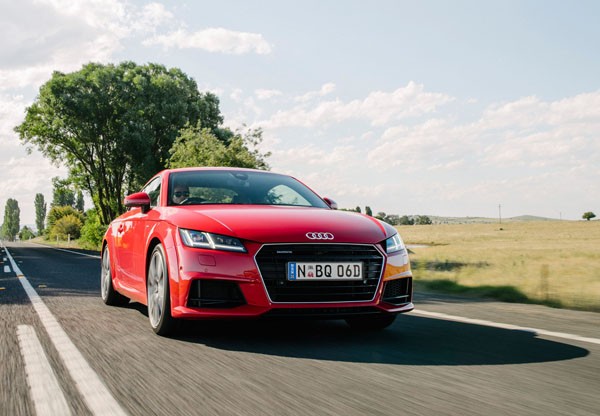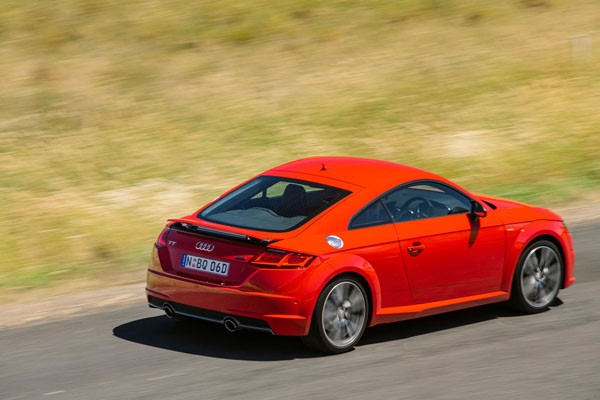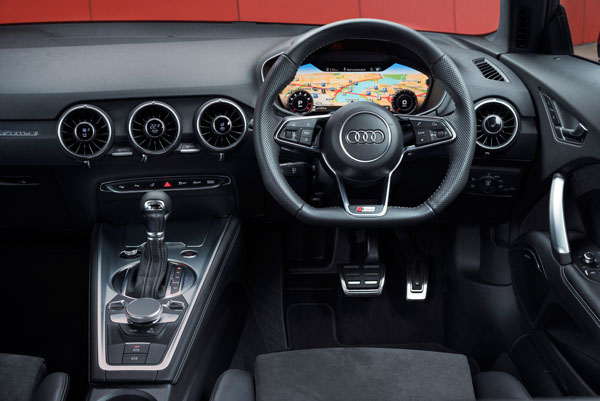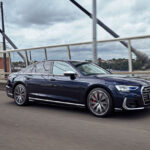In 1995 a group of automobile designers in four just weeks knocked up the concept of a new sports coupe, which was later to be described as one of ‘the most influential automotive designs in recent times’.
Within three years the first-generation Audi TT, closely based on that show car, was launched onto a welcoming market. The second-generation evolution hit the streets in 2006; now a new iteration of the compact sports coupe continues the revolution.
While calling on cues from the modern Audi R8 high-performance sports car, with its single frame grille with its six corners and thick crossbar dividing it into two zones, the new TT does hark back nicely to the original design.
From the side many details of the new Audi TT are reminiscent of the first-generation of the classic, while the flat greenhouse appears to be an independent unit.
The fuel flap on the shoulder sports the characteristic TT design with embossed TT logo and opens with a tap. There is no cap under the cover. The fuel nozzle is inserted directly into the tank neck in race-car fashion. Six bolts connect the ring of the fuel flap to the body.
The two large, round chrome-tipped tailpipes are closely spaced just like the first Audi TT. The same is true of the rounded rear window, the taillights integrated into the body and the three-dimensional logo.
An S line exterior package makes the design of the bumpers, air intakes, single frame, side sills and the rear diffuser even sharper.
The latest Audi TT introduces Matrix LED headlights, where the high beam is broken up into twelve small light-emitting diodes per headlight.
There are two reflectors for two groups of five LEDs; two LEDs use another reflector. The control unit, which communicates with a camera in the rear view mirror, switches the individual light-emitting diodes on and off or dims them in 64 steps, depending on the situation.
The headlight system can produce several hundred million light patterns. It prevents other road users from being blinded by glare and ensures that the road is always as brightly illuminated as possible.
Intelligent cornering light, which is created by a shift in the light centre position, works with the optional MMI navigation-plus system and uses GPS data to illuminate the road’s curve just before the steering wheel is turned.
The standard LED tail lights follow the headlight design system. The rear light is emitted through their homogenising polymer struts. The third brake light is situated on the edge of the boot lid.
Weight has been shed, with the new Audi TT 2.0 TFSI with manual transmission and front-wheel drive weighing 1230 kilograms, 50 kilogram less than its predecessor.
The skin of the new TT is aluminium, including the front fenders, roof, bonnet, doors and rear hatch. The last two components alone save a total of 15.5 kilograms over steel.
A co-efficient of friction of Cd 0.29, with the S line exterior package, puts the new TT at the head of the segment. At 120 km/h a spoiler deploys from the rear hatch, at 250 km/h generating roughly 50 kilograms of downforce on the rear axle. The spoiler retracts when the speed drops below 70 km/h.
New Audi TT is powered by a 2.0-litre TFSI four-cylinder engine putting out 169 kW and 370 Nm. With forced induction replacing displacement, together with direct injection and stop-start engine technology, high efficiency results. The engine complies with the Euro 6 emission standards.
Mated with a six-speed manual transmission and front-wheel drive, the coupe accelerates from 0 to 100 km/h in 6.0 seconds. Top speed is 250 km/h. Official fuel consumption is a claimed 5.9 litres per 100 kilometres, with carbon dioxide emissions of 137 grams per kilometre.
With the six-speed S tronic and quattro all-wheel drive, zero to 100 km/h comes up in 5.3 seconds, with fuel consumption of 6.4 litres per 100 kilometres in the combined urban / highway cycle and 149 grams of CO2 per kilometre.
In middle-of-the-road motoring in automatic mode, the six-speed S tronic changes gears in hundredths of a second with little noticeable power drop. In manual mode, which it can be operated using either the gearshift lever or steering wheel paddles, the driving style is satisfyingly sporty and the revs are higher.
Launch Control with S tronic manages full acceleration from a standstill with controlled wheel slip.
The TT marks the first time the all-wheel drive system has been integrated into the Audi drive select system, where it considers steering angle while at the same time orienting on the operation of drive select and the electronic stabilisation control. The clutch can already begin sending a portion of the torque to the rear axle when the driver turns enthusiastically into a bend. As soon as the driver steps on the accelerator, this torque presses the coupe smoothly into the corner with no initial understeer. The front axle straightens the car again when exiting the corner.
The new coupe comes standard with progressive steering, rack geared to produce different boost ratios depending on the steering angle. The TT 2.0 TFSI comes standard with 18-inch lightweight wheels and 245/40 tyres. Options offered include 18, 19 and 20-inch wheels.
Focus of the cabin is the wing-like instrument panel which is angled towards the driver. Characteristic TT round air vents incorporate all air-conditioning controls on their axes and in deluxe standard also display the settings.
The absence of the traditional air-con control unit frees up space for an expansive Audi virtual cockpit, combining the instrument cluster and MMI monitor into a digital unit. Central to the Audi virtual cockpit is a 12.3-inch, high-resolution display producing sharp, high-contrast images.
The driver can switch between two interfaces using the ‘View’ button on the multifunction steering wheel. In ‘Progressive’ mode, a central window offers a big view of navigation map or for lists in the Phone, Radio and Audio areas.
The tachometer and speedometer are displayed as small dial instruments on the right and left. In the ‘Classic’ view, the middle window is smaller, and the instruments – with black scales, red needles and white numerals – are equivalent in size to analog instruments.
The MMI system has been revised to ape smartphones where logic replaces static menu trees, and frequently used functions can be reached with just a few clicks. The centre of the terminal continues to be the round rotary pushbutton, its surface is equipped with the touch-sensitive MMI touch. The touchpad is used to input characters and now also processes finger gestures.
Audi aims to help drivers with a range of assistance systems allowing them to concentrate on the road. Optional Audi side assist helps the driver when changing lanes, with radar sensors monitoring the road behind to 70 metres.
The optional Audi active lane assist becomes active at speeds of above roughly 65 km/h. A video camera in the interior mirror identifies the lane markings on the road surface. If the car begins to approach one of the lane markings without a turn signal being activated, it guides the car back into the lane.
Standard equipment in the new coupe is the secondary collision brake assist, which is activated in the event of an accident. It can prevent the car from continuing to roll in an uncontrolled manner, and it activates the car’s interior lighting and hazard warning system. Another standard feature is the ‘rest recommendation’, which lets the driver know when he they are starting to get fatigued.
Out of the three new TT models at the launch, I had the pleasure of experiencing two, the S tronic Sport and its quattro S tronic S line sibling. First up the S tronic Sport with options which included metallic paint (silver), LED headlights, Audi Sport 19-inch alloy wheels, with luxury car tax payable before on-road cost, taking the total price to $80,692.
There is no ignoring the Audi TT is a two-door 2+2 with all the inherent disadvantages of getting in and out of the back. Then there’s the skinny leg room, good only, I suggest, for short journeys.
Boot space, on the other hand, is good enough to take two weekend cases, plus the odd package or two.
Font seats are comfortable and supportive. Going is smooth, if a little unexciting, while visibility, especially to the rear, is all you could ask of a sleek sports coupe..
Steering errs on the soft side for a sports car, as does the suspension. Brakes do their stuff admirably.
Second cab off the rank was the top-dog quattro S tronic S line with metallic paint, Audi Matrix LED headlights, Assistance and leather package, coloured interior bits in quartz finish, anthracite, plus Bang and Olufsen supreme sound putting the price at $93,420, plus on-roads.
This was a different animal altogether, trim, taut and terrific. The all-wheel drive giving the driver the confidence not to ease off, even on bends that tightened unnervingly.
Audi estimates the take-up of the new TT will be 43 per cent female in their mid-to-late thirties, 47 per cent males above 25. If only some of us could turn back the clock.
MODEL LINE-UP
Audi TT 2.0 TFSI Sport manual: $71,950
Audi TT 2.0 TFSI S tronic Sport: $74,950
Audi TT 2.0 TFSI quattro S tronic S Line: $85,450
Note: These prices do not include dealer or government charges. Contact your local Audi dealer for drive-away prices.














